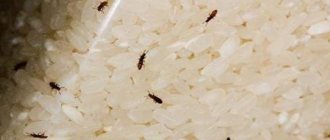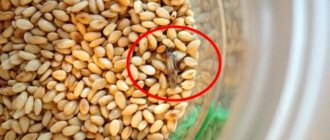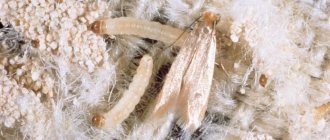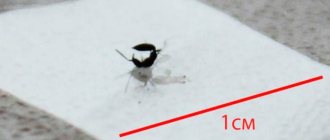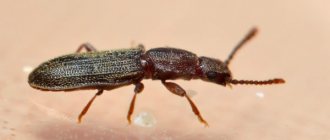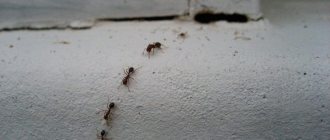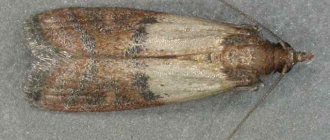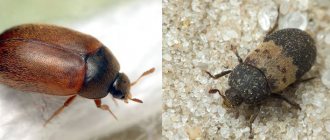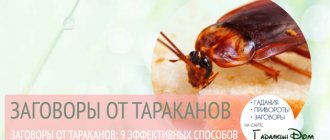Causes of flour bugs
It's easy to get bugs. Both the owner and the manufacturer of the product can provoke their appearance. This may be a violation of GOST technologies or storage conditions and incorrect “neighborhood” in the warehouse, a violation of the tightness of the packaging, the expiration of the cereal, or ingress from the outside.
Through the fault of the housewife, infection can occur at home:
- Improper storage of cereals. Increased dampness in the house and storage in unsealed conditions create conditions for the appearance of insects. Cereals should not be stored in a warm place.
- Storage of expired products. Cereals that have been stored for a long time have a much higher chance of becoming food for pests. You should always check the expiration date and throw away bad cereals promptly.
- Incorrect packaging. When storing in bags, they should be closed, avoiding open areas. Ideal containers are glass or plastic containers with lids.
Treats from relatives and neighbors can also cause infection. Especially if you take from your hands products that are loved by pests. These are not necessarily cereals; sometimes insects can enter the house with other household items.
Some places are favorite among harmful insects. Especially because they are the hardest to find there:
- Food products and their remains in bags, unsealed containers and other containers. Especially tea leaves, seasonings, dried fruits.
- In a kitchen set, they become the sole owners of the shelves and are able to gnaw holes in them.
- Other furniture.
Risk areas include the cooking area, where waste particles are regularly left behind.
Attention! They can get into the house in a thousand ways, from barley borrowed by a neighbor to purchased furniture and equipment.
In some cases, bugs can settle in places that are “inedible” for them. Therefore, when buying products secondhand or borrowing products from someone, it is better to be vigilant. Goods purchased by weight or at fairs are also dangerous.
Prevention of occurrence
It is easier to avoid the appearance of any insects with the help of simple manipulations than to then spend a lot of time and effort fighting them.
Tips on how to prevent beetles:
- When buying bulk products, look at the production date and expiration date.
- Check the packaging for integrity.
- If possible, inspect the product for quality (presence of debris) and the presence of living creatures in it.
- Regularly clean food storage areas.
- It is better to keep bulk products in plastic or glass, but always transparent containers. This makes it easier to control the presence of inedible additives in it.
By taking standard precautions when purchasing food, you can protect your home from insect infestations. You should not stock up on cereals, flour, or pasta for future use. Large amounts of food are harder to keep track of.
Did you like the article? Save it to your Pinterest! Hover over the image and click “Save.”
What bugs are found in cereals and flour?
Cockroaches at home cannot start just because the housewife has a shelf with cereals in her apartment. And they are stationed in other places. Their favorite places are where food scraps can be found. Therefore, they live near sinks and sinks, kitchen stoves, window sills and waste bins. But if there is cereal or other foods along the cockroach’s route, they will not refuse the meal. There are cockroaches in cereals and flour, provided that they have already settled in the house before.
In cereals and flour there are:
- Bread grinder. Small brown beetle. May have brownish-brown tints. They are about 3 mm long, but can fly. Due to the fact that it is often found in medications, it is also called “Pharmaceutical”. Not afraid of sunlight. It starts mainly in bread, but as it multiplies it affects everything, from food to furniture and household items.
- Flour beetle. It is called the small hruschak because of its small size. The maximum size is 3 mm. It looks like a regular beetle and has wings and antennae. However, he does not use his wings for their intended purpose. Painted red-brown or dark brown. Favorite foods are cereals and flour, but he does not disdain other products. Particularly dangerous due to the fact that it is extremely difficult to remove. Its second name is Mukoed Suriname.
- Red flour eater. A bug that loves flour. The fight is made difficult by the microscopic size of the pest - 1.5 mm. There are large specimens up to 2.5 mm in size. Lives in grain industry enterprises. But it will not start in flour stored at the required temperatures and humidity levels. It has a yellowish tint, similar to rust.
- Food moth. It may simply fly out the window, finding food to settle and reproduce. Has wings and can fly. The length of its body is 10 mm. Prefers bulk products, grains, raisins, dried apricots and prunes. It reproduces quickly with the help of laid larvae that grow into caterpillars. The caterpillars, in turn, become butterflies.
- Weevils. They have a large size for bugs - 5 mm. They can fly and have a high reproduction rate. Their favorite food is rice, which is why the pest is called rice weevil. But pests easily consume any cereal and even fruit crops.
- Southern barn moths. Another representative of butterflies. They enjoy nuts or dried fruits.
Once inside the house in a purchased package, pests quickly occupy food shelves, instantly multiplying. Due to their small size, they hide well in cabinets and bags.
How do aliens get to us?
Where do these guests come from? Most often they end up in bags in warehouses. There, all bulk products are in open containers. Once you hit one bug, it will quickly lay eggs. And now the bag is inhabited by larvae, from which small insects emerge. Then they move into kitchen cabinets, where they multiply beautifully.
According to technology, manufacturers of packaged products must treat them with a special composition that destroys unnecessary living creatures. But not all workers in this industry carry out processing, so the animals end up in cabinets from bags where bulk products are packaged.
What should you do to avoid bringing these animals into your home? When buying pasta, cereals, flour, pay attention to the following signs:
- Presence of tiny lumps in the package. These could be bugs matted in clumps;
- If the packages have small holes, this is a sure sign of the presence of harmful animals;
- An incomprehensible rustling sound in the product package;
- Rice or buckwheat grains can be eaten. This means that there are bugs in this package;
- There is flour at the bottom of the bag of cereal, which means the bugs are gnawing on the grains, and the remains fall to the bottom.
Ways to fight
There are various ways to get rid of pests, each homeowner can choose the appropriate one. You need to do a number of things first. Go through all bulk products and identify the source of contamination and affected packages. All provisions need to be checked, even if this type of food is not typical for beetles. If there are bugs in the cereal, then we get rid of it immediately, if there are bugs in the flour, then get rid of the flour, etc. Everything should be thrown into the trash immediately.
You should carry out general cleaning without missing a single detail. They wash all food containers, cabinets, furniture, household appliances, radiators, floors and window sills. It should be remembered that a colony can be anywhere.
On a note!
To wash containers, use soda; for the rest, dilute vinegar and use standard cleaning products.
It is better to block access to all joints and gaps in the apartment. Bulk products are poured into sealed containers and not used for 2 weeks. During this time, it will become clear whether the food is affected or not.
Are pests dangerous to health?
Why are small insects dangerous to health? For an adult in good health, they are not dangerous, it’s just unpleasant to realize that someone is rummaging through the cereal. Another thing is children or people with weak immune systems. They may develop allergies after eating these foods.
Parents do not understand where it comes from in their child, and the cause may be harmful insects.
They can also cause poisoning of the body, which will lead to gastrointestinal upset, even an increase in body temperature.
Before using these products as food, the bugs must be removed. It is more difficult to get rid of their waste products. In this case, more careful processing will be required.
Chemical methods and store-bought products
Chemical methods can affect people's well-being, so strict adherence to safety precautions is necessary when using them. As a rule, the instructions for use contain information about the period during which you cannot enter the premises.
On a note!
The most commonly used are insecticides or chlorine and chlorine-containing products.
The store shelves have a huge assortment to suit every taste, color and budget. Here are the most popular options:
- Pyrethrum is considered one of the safest chemicals. It is made in the form of a powder, which is laid out in hidden places and near cereals. The substance is safe for people and animals, but it is better to exercise caution.
- Anti-bug is intended for treating flat surfaces in order to destroy and prevent the appearance of pests (black bugs, food moths). Hazardous to health if it enters human organs.
- Rogneda is another chemical that requires caution in use. It works not only on bugs, but also on many other pests. For example, cockroaches.
- Dichlorvos is a fast-acting aerosol. Effectively eliminates bugs without giving them a chance. Spray only using special protective equipment.
You can use Dust, Whiteness and other compounds. If the owner determines the type of beetle, then you can pick up the remedy in any specialized store.
Reproduction
They reproduce profusely. Mating is a three-step process: the male chases the female, mounts her, inserts the copulatory organ, and injects seminal fluid. Over the course of several days, the female burrows into soft soil and lays about 500 eggs.
Adult beetle
After 4–19 days, the larvae hatch. They are threatened by many predators, including reptiles.
Larva
During the larval phase, the mealworm feeds on plants and dead insects and molts between each stage (9 to 20 times). After the final molt, it turns into a pupa. The new pupa is whitish and eventually turns brown. After 3–30 days, depending on environmental conditions, primarily temperature, it becomes an adult insect.
Doll
Different stages: larvae, pupa, adult beetles - just emerged from the pupa and already blackened
Sex pheromones
A sex pheromone secreted by male beetles has been identified. Inbreeding reduces the attractiveness of these pheromones. Females are more attracted to the odors emitted by outbred (heterotic) males than by the odors emitted by inbred ones. The reduction in male signaling capacity may be due to increased expression of homozygous deleterious recessive alleles caused by inbreeding.
An adult beetle that has recently emerged from the pupa and has not yet completely darkened
Tips for housewives to protect their supplies
How to keep stocks intact? Protective measures must be observed:
- Store bulk products in glass jars or plastic containers. Containers must be tightly closed with lids.
- Purchased products must be carefully inspected.
- Don't turn your kitchen into a food warehouse. The fewer products are stored on shelves, the lower the risk of “infection” with bugs.
- Cereals should be stored for no more than two to four months.
- Treat kitchen cabinets and storage containers with a solution of vinegar or soda every 2-3 months.
Only a thorough inspection and preventive measures will help protect your supplies from the proliferation of pests.
Dear friends, a shortage of goods is not expected yet, so there is no need to stock up for future use. And if this has already happened, then you already know how to get rid of bugs in cereals.
How to get rid of bugs
Fighting insects with chemicals is not recommended. After it, you need to carry out general cleaning and ventilation of the room, and this is not always possible, especially in winter. To get started, here are some tips you can use:
- If the number of insects is small, then you can put the packages of cereal in the freezer and take it out after a day. The insects will have no chance to survive. Next, sift the bulk product several times and dry it.
- Place the cereal in the oven and turn it on at 120 degrees, leave for 20-30 minutes. We rinse well under running water, then dry again on the table or in the oven.
- Salt water will bring parasites to the surface. Then we pour the bugs into the sewer, and wash the cereal several times and dry it.
- It’s more difficult with flour, because... it cannot be washed. You can use a small seeder, but it is better not to use such a product for food and throw it away.
